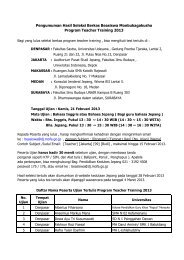9700_y16_sy
9700_y16_sy
9700_y16_sy
Create successful ePaper yourself
Turn your PDF publications into a flip-book with our unique Google optimized e-Paper software.
Cambridge International AS and A Level Biology <strong>9700</strong> <strong>sy</strong>llabus Syllabus content<br />
14 Homeostasis<br />
Cells function most efficiently if they are kept in near constant conditions. Cells in multicellular animals<br />
are surrounded by tissue fluid. The composition, pH and temperature of tissue fluid are kept constant<br />
by exchanges with the blood as discussed in the section on Transport in mammals. In mammals, core<br />
temperature, blood glucose concentration and blood water potential are maintained within narrow limits<br />
to ensure the efficient operation of cells. Prior knowledge for this section includes an understanding<br />
that waste products are excreted from the body – a role that is fulfilled by the kidneys – and an outline<br />
of the structure and function of the nervous and endocrine <strong>sy</strong>stems. In plants, guard cells respond to<br />
fluctuations in environmental conditions and open and close stomata as appropriate for photo<strong>sy</strong>nthesis<br />
and conserving water.<br />
Candidates will be expected to use the knowledge gained in this section to solve problems in familiar and<br />
unfamiliar contexts.<br />
Learning outcomes<br />
Candidates should be able to:<br />
14.1 Homeostasis in mammals<br />
Homeostasis in mammals<br />
requires complex <strong>sy</strong>stems to<br />
maintain internal conditions<br />
near constant.<br />
The kidneys remove wastes<br />
from the blood and are the<br />
effectors for controlling the<br />
water potential of the blood.<br />
a) discuss the importance of homeostasis in mammals and<br />
explain the principles of homeostasis in terms of internal<br />
and external stimuli, receptors, central control, co-ordination<br />
<strong>sy</strong>stems, effectors (muscles and glands)<br />
b) define the term negative feedback and explain how it is<br />
involved in homeostatic mechanisms<br />
c) outline the roles of the nervous <strong>sy</strong>stem and endocrine<br />
<strong>sy</strong>stem in co-ordinating homeostatic mechanisms, including<br />
thermoregulation, osmoregulation and the control of blood<br />
glucose concentration<br />
d) describe the deamination of amino acids and outline the<br />
formation of urea in the urea cycle (biochemical detail of the<br />
urea cycle is not required)<br />
e) describe the gross structure of the kidney and the detailed<br />
structure of the nephron with its associated blood vessels<br />
using photomicrographs and electron micrographs<br />
f) describe how the processes of ultrafiltration and selective<br />
reabsorption are involved with the formation of urine in the<br />
nephron<br />
g) describe the roles of the hypothalamus, posterior pituitary,<br />
ADH and collecting ducts in osmoregulation<br />
h) explain how the blood glucose concentration is regulated by<br />
negative feedback control mechanisms, with reference to<br />
insulin and glucagon<br />
i) outline the role of cyclic AMP as a second messenger with<br />
reference to the stimulation of liver cells by adrenaline and<br />
glucagon<br />
j) describe the three main stages of cell signalling in the control<br />
of blood glucose by adrenaline as follows:<br />
• hormone-receptor interaction at the cell surface (see 4.1c)<br />
• formation of cyclic AMP which binds to kinase proteins<br />
• an enzyme cascade involving activation of enzymes by<br />
phosphorylation to amplify the signal<br />
Back to contents page<br />
www.cie.org.uk/alevel<br />
35





